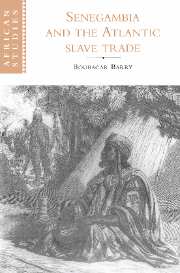Book contents
- Frontmatter
- Contents
- Preface
- Map
- I Senegambia from the fifteenth to the seventeenth century: a haven for incoming populations, a station for migrants on the move
- II Senegambia in the eighteenth century: the slave trade, ceddo regimes and Muslim revolutions
- III Senegambia in the first half of the nineteenth century: legitimate trade and sovereignty disputes
- IV Senegambia in the second half of the nineteenth century: colonial conquest and resistance movements
- Conclusion
- Notes
- Bibliography
- Index
- Other books in the series
Conclusion
Published online by Cambridge University Press: 31 October 2009
- Frontmatter
- Contents
- Preface
- Map
- I Senegambia from the fifteenth to the seventeenth century: a haven for incoming populations, a station for migrants on the move
- II Senegambia in the eighteenth century: the slave trade, ceddo regimes and Muslim revolutions
- III Senegambia in the first half of the nineteenth century: legitimate trade and sovereignty disputes
- IV Senegambia in the second half of the nineteenth century: colonial conquest and resistance movements
- Conclusion
- Notes
- Bibliography
- Index
- Other books in the series
Summary
Prior to the fourteenth and fifteenth centuries, Senegambia, situated at the intersection of two historic West African zones, the Sahara and the Sudan, functioned mainly as a final destination for migratory populations. For that reason, it was not a theater for particularly important developments. Still, it did serve, even then, as a meeting place and a point of departure for all populations and influences flowing in and out of the savanna, the desert, and the forest zones. The Senegal and Gambia rivers, along with the numerous rivers furrowing the territory all the way to the Kolente, played a key role in the integration of this westernmost part of West Africa into existing economic networks, all oriented, at that time, either northward through the Sahara, eastward through the Niger Bend, or southward through the forest zone.
Because Senegambia was a spillover zone for people migrating from the Sahara desert, the Niger basin, and the forest zone, the region's population was typically diverse. Here were Wolof, Peul, and Tukulor groups, Manding, Sereer, and Berber, Susu, Joola and Nalu, Baga, Beafada, Tenda, and so on. This demographic diversity was underscored by a tendency toward geographical variety. The most obvious difference is between northern Senegambia, comprising the Senegal river valley and the western plains between that river and the Gambia river, and southern Senegambia, comprising the Southern Rivers region and the Futa Jallon plateau.
- Type
- Chapter
- Information
- Senegambia and the Atlantic Slave Trade , pp. 303 - 314Publisher: Cambridge University PressPrint publication year: 1997



